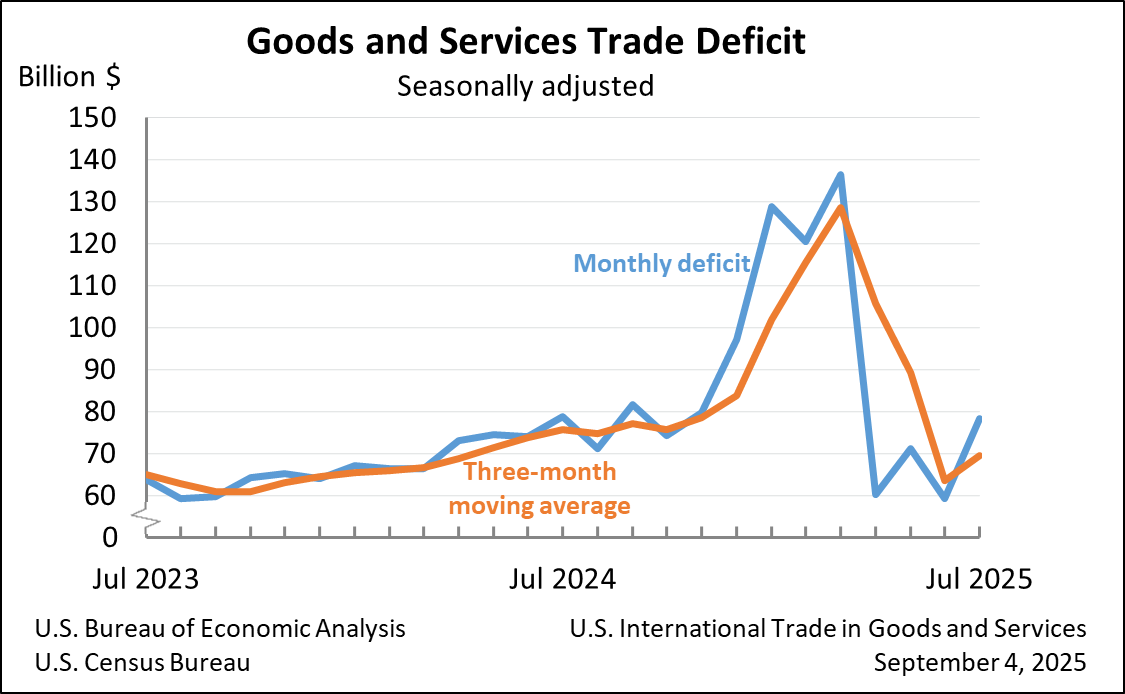Bureau of Economic Analysis
U.S. International Trade in Goods and Services, July 2025
The U.S. goods and services trade deficit increased in July 2025 according to the U.S. Bureau of Economic Analysis and the U.S. Census Bureau. The deficit increased from $59.1 billion in June (revised) to $78.3 billion in July, as imports increased more than exports. The goods deficit increased $18.2 billion in July to $103.9 billion. The services surplus decreased $1.1 billion in July to $25.6 billion.
Principal Federal Economic Indicators
Noteworthy
The Latest
Revised Statistics of Gross Domestic Product by Industry, 2009-2011
Retail trade and durable goods manufacturing were the leading contributors to the deceleration in U.S. economic growth in 2011, according to revised statistics on the breakout of real gross domestic product (GDP) by industry from the Bureau of Economic Analysis. Real GDP growth slowed in 2011, increasing 1.8 percent after increasing 2.4 percent in 2010. The revised statistics do not change the general picture of the economy: 12 of 22…
The Use Table: An Essential Tool That Looks Deep Inside the U.S. Economy
What’s the foundation for many economic statistics both inside and outside the Bureau of Economic Analysis (BEA)? It’s something most people have never heard of, yet it is essential for finding out what’s going on inside the world’s largest economy. It’s called the “use table,” and it is a fundamental tool of BEA’s input-output accounts. The use table provides both a broad and a detailed look at the U.S. economy. It is simple, yet…
September 2012 Trade Gap is $41.5 Billion
The U.S. monthly international trade deficit decreased in September 2012, according to the U.S. Bureau of Economic Analysis and the U.S. Census Bureau. The deficit decreased from $43.8 billion (revised) in August to $41.5 billion in September, as exports increased more than imports. The previously published August deficit was $44.2 billion. The goods deficit decreased $1.4 billion from August to $57.5 billion in September, and the services…
New Guide Helps Regional Developers, Planners Navigate RIMS II
People who conduct or examine local or regional economic impact studies will want to read a new handbook that offers some dos and don’ts on using the Bureau of Economic Analysis (BEA) Regional Input-Output Modeling System (RIMS II).
RIMS II, a regional economic model, is most frequently used by investors, regional planners, and government officials to gauge the economy-wide impact of a change in economic activity on a local community…
Real Consumer Spending Picks Up in September
Personal income increased 0.4 percent in September after increasing 0.1 percent in August. Wages and salaries, the largest component of personal income, increased 0.3 percent in September after increasing 0.1 percent in August. Government social benefits to persons turned up in September.
Current-dollar disposable personal income (DPI), after-tax income, increased 0.4 percent in September after increasing 0.1 percent in August.…
Personal Income and Outlays, September 2012
Personal income increased $48.1 billion, or 0.4 percent, and disposable personal income (DPI) increased $43.0 billion, or 0.4 percent, inSeptember, according to the Bureau of Economic Analysis. Personal consumption expenditures (PCE) increased $87.9 billion, or 0.8 percent. In August, personal income increased $17.8 billion, or 0.1 percent, DPI increased $15.1 billion, or 0.1 percent, and PCE increased $59.9 billion, or 0.5 percent, based on…
GDP Growth Picks up in Third Quarter
Real gross domestic product (GDP) increased 2.0 percent in the third quarter of 2012 after increasing 1.3 percent in the second quarter, according to estimates released today by the Bureau of Economic Analysis.
Third-quarter highlights The following contributed to the acceleration in real GDP growth:
Gross Domestic Product, 3rd quarter 2012 (advance estimate)
Real gross domestic product -- the output of goods and services produced by labor and property located in the United States -- increased at an annual rate of 2.0 percent in the third quarter of 2012 (that is, from the second quarter to the third quarter), according to the "advance" estimate released by the Bureau of Economic Analysis.
What is the U.S. Financial Account?
The U.S. financial account is a key component of the Bureau of Economic Analysis’ international transactions accounts (ITAs). The financial account presents the cross-border flows of funds generated by international financial activity. Cross-border flows of funds can be large and volatile because the financial markets are large and because the flows are influenced by changing financial market conditions as well as by changes in…




